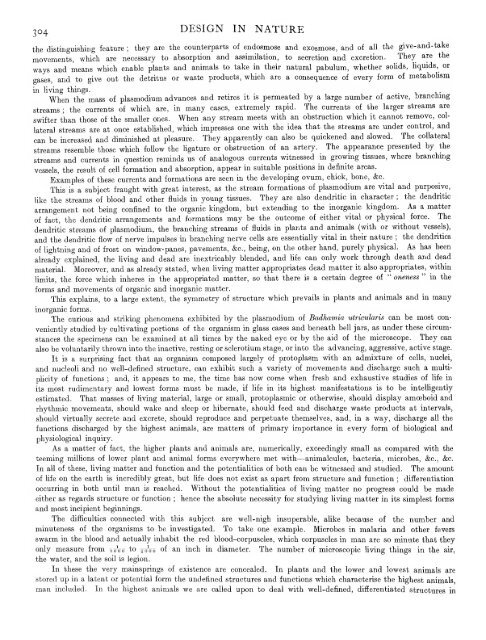Create successful ePaper yourself
Turn your PDF publications into a flip-book with our unique Google optimized e-Paper software.
304 DESIGN IN NATURE<br />
the distinguishing feature ; they are the counterparts of endosmose and exosmose, and of all the give-and-take<br />
movements, which are necessary to absorption and assimilation, to secretion and excretion. They are the<br />
ways and means which enable plants and animals to take in their natural pabulum, whether solids, liqmds, or<br />
gases, and to give out the detritus or waste products, which are a consequence of every form of metabolism<br />
in hving things.<br />
When the mass of plasmodium advances and retires it is permeated by a large number of active, branchmg<br />
streams ; the currents of which are, in many cases, extremely rapid. The currents of the larger streams are<br />
swifter than those of the smaller ones. When any stream meets with an obstruction which it cannot remove, col-<br />
lateral streams are at once estabhshed, which impresses one with the idea that the streams are under control, and<br />
can be increased and diminished at pleasure. They apparently can also be quickened and slowed. The collateral<br />
streams resemble those which follow the hgature or obstruction of an artery. The appearance presented by the<br />
streams and currents in question reminds us of analogous currents witnessed in growing tissues, where branching<br />
vessels, the result of cell formation and absorption, appear in suitable positions in definite areas.<br />
Examples of these currents and formations are seen in the developing ovum, chick, bone, &c.<br />
This is a subject fraught with great interest, as the stream formations of plasmodium are vital and purposive,<br />
like the streams of blood and other fluids in young tissues. They are also dendritic in character ; the dendritic<br />
arrangement not being confined to the organic kingdom, but extending to the inorganic kingdom. As a matter<br />
of fact, the dendritic arrangements and formations may be the outcome of either vital or physical force. The<br />
dendritic streams of plasmodium, the branching streams of fluids in plants and animals (with or without vessels),<br />
and the dendritic flow of nerve impulses in branching nerve cells are essentially vital in their nature ;<br />
the dendritics<br />
of hghtning and of frost on window-panes, pavements, &c., being, on the other hand, purely physical. As has been<br />
already explained, the living and dead are inextricably blended, and life can only work through death and dead<br />
material. Moreover, and as already stated, when Hving matter appropriates dead matter it also appropriates, within<br />
hmits, the force which inheres in the appropriated matter, so that there is a certain degree of " oneness " in the<br />
forms and movements of organic and inorganic matter.<br />
This explains, to a large extent, the symmetry of structure which prevails in plants and animals and in many<br />
inorganic forms.<br />
The curious and striking phenomena exhibited by the plasmodium of Badhamia lUricularis can be most con-<br />
veniently studied by cultivating portions of the organism in glass cases and beneath bell jars, as under these circum-<br />
stances the specimens can be examined at all times by the naked eye or by the aid of the microscope. They can<br />
also be voluntarily thrown into the inactive, resting or sclerotium stage, or into the advancing, aggressive, active stage.<br />
It is a surprising fact that an organism composed largely of protoplasm with an admixture of cells, nuclei,<br />
and nucleoh and no well-defined structure, can exhibit such a variety of movements and discharge such a multi-<br />
pUcity of functions ; and, it appears to me, the time has now come when fresh and exhaustive studies of life in<br />
its most rudimentary and lowest forms must be made, if life in its highest manifestations is to be intelUgently<br />
estimated. That masses of living material, large or small, protoplasmic or otherwise, should display amoeboid and<br />
rhythmic movements, should wake and sleep or hibernate, should feed and discharge waste products at intervals,<br />
should virtually secrete and excrete, should reproduce and perpetuate themselves, and, in a way, discharge all the<br />
functions discharged by the highest animals, are matters of primary importance in every form of biological and<br />
physiological inquiry.<br />
As a matter of fact, the higher plants and animals are, numerically, exceedingly small as compared with the<br />
teeming millions of lower plant and animal forms everywhere met with—animalcules, bacteria, microbes, &c., &c.<br />
In all of these, living matter and function and the potentialities of both can be witnessed and studied. The amount<br />
of life on the earth is incredibly great, but life does not exist as apart from structure and function ; differentiation<br />
occurring in both until man is reached. Without the potentialities of living matter no progress could be made<br />
either as regards structure or function ;<br />
hence the absolute necessity for studying living matter in its simplest forms<br />
and most incipient beginnings.<br />
The difficulties connected with this subject are well-nigh insuperable, alike because of the number and<br />
minuteness of the organisms to be investigated. To take one example. Microbes in malaria and other fevers<br />
swarm in the blood and actually inhabit the red blood-corpuscles, which corpuscles in man are so minute that they<br />
only measure from yjTrVo to joVu of an inch in diameter. The number of microscopic living things in the air,<br />
the water, and the soil is legion.<br />
In these the very mainsprings of existence are concealed. In plants and the lower and lowest animals are<br />
stored up in a latent or potential form the undefined structures and functions which characterise the highest animals,<br />
man included. In the highest animals we are called upon to deal with well-defined, differentiated structures in


